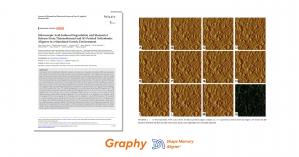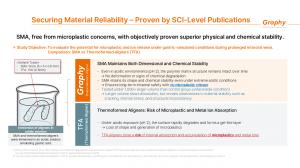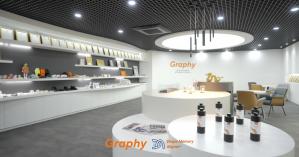Graphy Shape Memory Aligner (SMA) Demonstrates Structural Stability in Simulated Gastric Conditions

Cover page of the Journal of Biomedical Materials Research Part B and AFM scans of Graphy’s Shape Memory Aligner® surface in simulated gastric acid, illustrating its stable microscopic structure over time.

Scientific summary slide showing that Graphy’s Shape Memory Aligner® maintains both dimensional and chemical stability in acidic conditions, unlike thermoformed aligners that risk microplastic and metal ion release.
- Distinct Microscopic Degradation Patterns Compared with Thermoformed Aligners
- Distinct Microscopic Degradation Patterns Compared with Thermoformed Aligners
Concerns over the potential release of microplastics (MPs) and nanoplastics (NPs) from clear aligners during long-term wear or reuse have recently emerged as an important safety issue in oral healthcare. Despite this, little is known about how aligner materials behave under acidic environments such as those caused by acid reflux, vomiting, or consumption of acidic beverages while aligners are being worn.
A recent study addressed this knowledge gap by conducting a detailed analysis of how clear aligner materials respond to strongly acidic conditions (pH 2), equivalent to gastric acid. The findings highlight clear quantitative differences in structural and chemical stability depending on the material composition and manufacturing process.
The research, published in Journal of Biomedical Materials Research Part B: Applied Biomaterials (IF 4.8, Q1), is titled
“Microscopic Acid-Induced Degradation and Elemental Release from Thermoformed and 3D-Printed Orthodontic Aligners in a Simulated Gastric Environment.”
[Clear Contrast Under Acidic Conditions: “Dissolution” vs. “Structural Retention”]
Using an Atomic Force Microscope (AFM), the researchers compared a thermoformed aligner (TFA, multilayer polyurethane–copolyester) and the Shape Memory Aligner (SMA, urethane-acrylate-based 3D printed resin) under simulated gastric acid (pH 2 HCl).
The thermoformed material rapidly transformed into a gel-like phase upon acid exposure, losing its surface morphology and exhibiting severe degradation to the point where roughness analysis was impossible. This rapid disintegration indicates a higher likelihood of microplastic particle release.
In contrast, the SMA maintained its structural integrity, showing only gradual and uniform surface roughening over time.
After one hour of exposure, the average roughness (Sa) increased by approximately 8%, and the maximum height (Sz) by about 12%, indicating minimal corrosion and controlled microstructural change.
The researchers attributed this difference to the fundamental variation in chemical architecture and fabrication process, explaining that the shape-memory polymer network of the SMA resists acid-induced breakdown, preserving its structure even under harsh conditions.
[Establishing a New Benchmark for Microplastic Safety]
This study is the first quantitative analysis of micro- and nanoplastic behavior of clear aligners under simulated gastric conditions. The authors emphasized that “even aligners that appear similar may exhibit entirely different structural stability and elemental release patterns depending on their base materials and manufacturing methods.”
The SMA demonstrated acid-phase stability, retaining its morphology and chemical integrity even in strong acidic environments. These findings are directly related to key clinical factors such as long-term safety during wear, reduction in fracture risk, and mitigation of surface degradation, offering a new evidence-based foundation for evaluating the biostability of aligner materials.
With more than 200,000 clinical applications worldwide, SMA technology has already shown superior resistance to micro-corrosion, mechanical durability, and consistent orthodontic force retention compared with conventional thermoformed methods. This study provides fundamental scientific validation for those clinical observations, confirming that SMA materials maintain their integrity not only in clinical use but also in extreme environmental simulations.
Paper Information: https://doi.org/10.1002/jbm.b.35674
Bob Lee
Graphy inc.
+ +1 888-616-2764
email us here
Visit us on social media:
LinkedIn
Instagram
Facebook
YouTube
Essence of Shape Memory Aligner
Legal Disclaimer:
EIN Presswire provides this news content "as is" without warranty of any kind. We do not accept any responsibility or liability for the accuracy, content, images, videos, licenses, completeness, legality, or reliability of the information contained in this article. If you have any complaints or copyright issues related to this article, kindly contact the author above.



